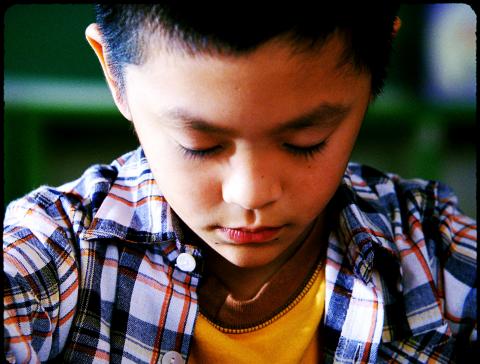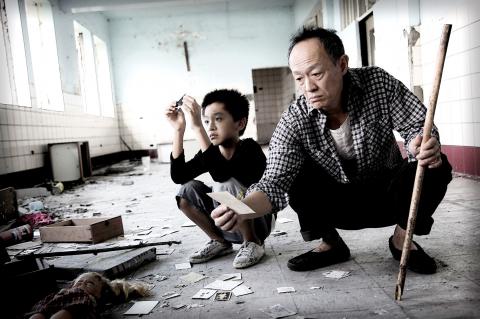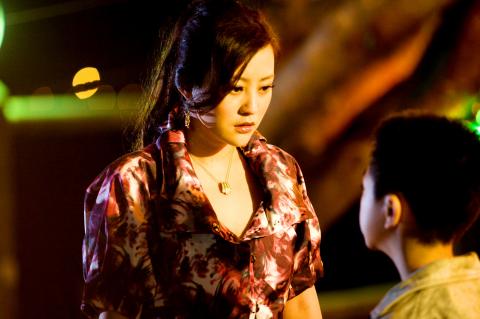After his critically acclaimed feature debut Parking (停車, 2008), a darkly comic urban drama, director Chung Mong-hong (鍾孟宏) moves to the countryside in the exquisitely crafted The Fourth Portrait (第四張畫). The atmospheric film takes a poignant look at the issue of domestic violence through the tale of a boy haunted by loss, and is enhanced by handsome cinematography and a top-notch cast that includes Taiwanese thespians Leon Dai (戴立忍) and King Shih-chieh (金士傑), as well as Hao Lei (郝蕾) from China.
Set in rural Taiwan, the film opens with 10-year-old Xiang, effortlessly played by newcomer Bi Xiao-hai (畢曉海), watching his father pass away in a hospital room. Left alone in the world, the boy manages to survive by stealing boxed meals. An elderly school janitor (played by King) takes Xiang under his wing.
Later Xiang’s estranged mother (played by Hao), remarried to a morose night market vendor (played by Dai), comes to take the boy to his new family. A sense of foreboding envelopes the movie when the train that the mother and son take speeds into a black tunnel, leaving the two devoured by darkness.

PHOTO COURTESY OF ATOM CINEMA
Xiang’s new home is cold and unwelcoming; the stepfather is rancorous and distant. His mother, a Chinese immigrant, seems exhausted by her life as a hostess at a ramshackle karaoke bar. The boy struggles to make sense of his hostile environment by sketching portraits, and finds solace in a newly found friendship with a portly outcast, played by entertainer Lin Yu-chih (林郁智), better known as Na Dou (納豆). The friend makes Xiang an accomplice to his petty crimes.
The story takes a menacing turn when Xiang draws a portrait inspired by a dream about his older brother, who disappeared some years earlier. A series of macabre incidents ensues, gradually laying bare a skeleton in the family closet.
Cowritten, shot and directed by Chung, the film shares a similar episodic approach to storytelling with Parking. The child protagonist’s series of encounters with odd characters offers gripping moments, but prevents the viewer from emotionally investing in the narrative. The distancing effect that works well in Parking to convey urban estrangement is often frustrating when one tries to grasp the emotional poignancy and depth suggested in The Fourth Portrait.

PHOTO COURTESY OF ATOM CINEMA
Nonetheless, Chung is a wizard at evoking moods. The director never shuns away from his background in TV commercials, weaving rich colors, polished compositions and fluid camera work into a cinematography that gives Taiwan’s countryside a dreamlike, surreal quality.
The bleak, hostile environment is inhabited not only by petty criminals and drifters but ominous dark clouds rolling in from a distance and toxic yellow fumes belching out of factories in the background. Most striking of all is the stepfather’s giant fish tank, which exudes an eerie blue light that doesn’t seem to be of this world.
The solid cast lends considerable strength and grace to the work. Hao, almost unrecognizable from her lauded big-screen debut in Lou Ye’s (婁燁) Summer Palace (頤和園, 2006), presents a powerful character study of a Chinese immigrant who comes to Taiwan in search of a better life but ends up disillusioned. Dai is stunningly fierce as the stepfather. Rather than a character grounded in real life, however, Dai’s role feels more like an embodiment of wickedness that seems out of synch with the other rural inhabitants.

PHOTO COURTESY OF ATOM CINEMA
Since his award-winning documentary Doctor (醫生) in 2006, Chung has honed a distinct style and unique sensibility. Given more time to refine his skills in storytelling and character development, the seasoned commercial filmmaker will no doubt grow into much more than a cinematic stylist.

This month the government ordered a one-year block of Xiaohongshu (小紅書) or Rednote, a Chinese social media platform with more than 3 million users in Taiwan. The government pointed to widespread fraud activity on the platform, along with cybersecurity failures. Officials said that they had reached out to the company and asked it to change. However, they received no response. The pro-China parties, the Chinese Nationalist Party (KMT) and Taiwan People’s Party (TPP), immediately swung into action, denouncing the ban as an attack on free speech. This “free speech” claim was then echoed by the People’s Republic of China (PRC),

Exceptions to the rule are sometimes revealing. For a brief few years, there was an emerging ideological split between the Democratic Progressive Party (DPP) and Chinese Nationalist Party (KMT) that appeared to be pushing the DPP in a direction that would be considered more liberal, and the KMT more conservative. In the previous column, “The KMT-DPP’s bureaucrat-led developmental state” (Dec. 11, page 12), we examined how Taiwan’s democratic system developed, and how both the two main parties largely accepted a similar consensus on how Taiwan should be run domestically and did not split along the left-right lines more familiar in

As I finally slid into the warm embrace of the hot, clifftop pool, it was a serene moment of reflection. The sound of the river reflected off the cave walls, the white of our camping lights reflected off the dark, shimmering surface of the water, and I reflected on how fortunate I was to be here. After all, the beautiful walk through narrow canyons that had brought us here had been inaccessible for five years — and will be again soon. The day had started at the Huisun Forest Area (惠蓀林場), at the end of Nantou County Route 80, north and east

Specialty sandwiches loaded with the contents of an entire charcuterie board, overflowing with sauces, creams and all manner of creative add-ons, is perhaps one of the biggest global food trends of this year. From London to New York, lines form down the block for mortadella, burrata, pistachio and more stuffed between slices of fresh sourdough, rye or focaccia. To try the trend in Taipei, Munchies Mafia is for sure the spot — could this be the best sandwich in town? Carlos from Spain and Sergio from Mexico opened this spot just seven months ago. The two met working in the